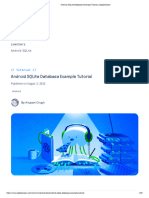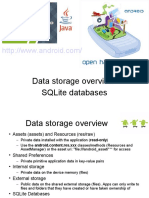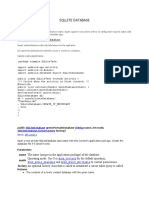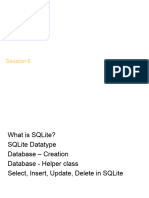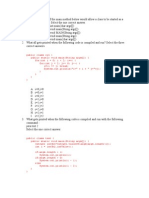0 ratings0% found this document useful (0 votes)
5 viewsAndroid Database -SQLite Database
The document provides an overview of Android's SQLite database, detailing its embedded nature and how it differs from traditional database management systems. It explains the use of database schemas, the SQLiteOpenHelper class for managing database creation and upgrades, and methods for data manipulation such as insert, update, and delete. Additionally, it includes examples of code for implementing these functionalities in Android applications.
Uploaded by
hlama7681Copyright
© © All Rights Reserved
We take content rights seriously. If you suspect this is your content, claim it here.
Available Formats
Download as PPT, PDF, TXT or read online on Scribd
0 ratings0% found this document useful (0 votes)
5 viewsAndroid Database -SQLite Database
The document provides an overview of Android's SQLite database, detailing its embedded nature and how it differs from traditional database management systems. It explains the use of database schemas, the SQLiteOpenHelper class for managing database creation and upgrades, and methods for data manipulation such as insert, update, and delete. Additionally, it includes examples of code for implementing these functionalities in Android applications.
Uploaded by
hlama7681Copyright
© © All Rights Reserved
We take content rights seriously. If you suspect this is your content, claim it here.
Available Formats
Download as PPT, PDF, TXT or read online on Scribd
You are on page 1/ 28
Kenya institute of software engineering
Mobile Development II
Android Database -SQLite Database
URL: www.KenyaInstituteofsoftwareengineering.com Lecturer: Mr. John Kinyanjui
Tel: +254 202529389, +254 713 810 752, +254 732 609 809 email: kenyainstituteofsoftwareeng@gmail.com
Introduction
Android has its own technology for
working with databases and it has
nothing to do with Java Database
Connectivity (JDBC), the technology Java
developers use for accessing data in a
relational database.
In addition, Android ships with SQLite, an
open source database.
URL: www.KenyaInstituteofsoftwareengineering.com Lecturer: Mr. John Kinyanjui
Tel: +254 202529389, +254 713 810 752, +254 732 609 809 email: kenyainstituteofsoftwareeng@gmail.com
Database schema
Database Schemas define the
characteristics of the data stored in a
database table. For example, the table
schema for a customer database table
might define that the customer name is
a string of no more than 20 characters in
length, and that the customer phone
number is a numerical data field of a
certain format.
URL: www.KenyaInstituteofsoftwareengineering.com Lecturer: Mr. John Kinyanjui
Tel: +254 202529389, +254 713 810 752, +254 732 609 809 email: kenyainstituteofsoftwareeng@gmail.com
Database schema
Schemas are also used to define the
structure of entire databases and the
relationship between the various tables
contained in each database.
URL: www.KenyaInstituteofsoftwareengineering.com Lecturer: Mr. John Kinyanjui
Tel: +254 202529389, +254 713 810 752, +254 732 609 809 email: kenyainstituteofsoftwareeng@gmail.com
SQLite
SQLite is an embedded, relational
database management system
(RDBMS).
SQLite is referred to as embedded
because it is provided in the form of a
library that is linked into applications.
URL: www.KenyaInstituteofsoftwareengineering.com Lecturer: Mr. John Kinyanjui
Tel: +254 202529389, +254 713 810 752, +254 732 609 809 email: kenyainstituteofsoftwareeng@gmail.com
SQLite
As such, there is no standalone database
server running in the background.
All database operations are handled
internally within the application through
calls to functions contained in the SQLite
library.
URL: www.KenyaInstituteofsoftwareengineering.com Lecturer: Mr. John Kinyanjui
Tel: +254 202529389, +254 713 810 752, +254 732 609 809 email: kenyainstituteofsoftwareeng@gmail.com
SQLite
SQLite is written in the C programming
language and as such, the Android SDK
provides a Java based “wrapper” around
the underlying database interface. This
essentially consists of a set of classes
that may be utilized within the Java or
Kotlin code of an application to create
and manage SQLite based databases.
URL: www.KenyaInstituteofsoftwareengineering.com Lecturer: Mr. John Kinyanjui
Tel: +254 202529389, +254 713 810 752, +254 732 609 809 email: kenyainstituteofsoftwareeng@gmail.com
The Database API
The SQLiteDatabase and
SQLiteOpenHelper classes, both part
of android.database.sqlite, are the
two most frequently used classes in the
Database API.
In the android.database package, the
Cursor interface is one of the most
important types.
URL: www.KenyaInstituteofsoftwareengineering.com Lecturer: Mr. John Kinyanjui
Tel: +254 202529389, +254 713 810 752, +254 732 609 809 email: kenyainstituteofsoftwareeng@gmail.com
The SQLiteOpenHelper Class
To use a database in your Android
application, extend SQLiteOpenHelper
to help with database and table creation
as well as connecting to the database.
In a subclass of SQLiteOpenHelper,
you need to do the following.
URL: www.KenyaInstituteofsoftwareengineering.com Lecturer: Mr. John Kinyanjui
Tel: +254 202529389, +254 713 810 752, +254 732 609 809 email: kenyainstituteofsoftwareeng@gmail.com
The SQLiteOpenHelper Class
Provide a constructor that calls its
super, passing, among others, the
Context and the database name.
Override the onCreate and
onUpgrade methods.
URL: www.KenyaInstituteofsoftwareengineering.com Lecturer: Mr. John Kinyanjui
Tel: +254 202529389, +254 713 810 752, +254 732 609 809 email: kenyainstituteofsoftwareeng@gmail.com
onCreate() and onUpgrade()
onCreate(), called when there is no database
and your app needs one, which passes you a
SQLiteDatabase object, pointing at a newly-
created database, that you use to populate
with tables and initial data, as appropriate.
onUpgrade(), called when the schema version
you are seeking does not match the schema
version of the database, which passes you a
SQLiteDatabase object and the old and new
version numbers, so you can figure out how
best to convert the database from the old
schema to the new one.
URL: www.KenyaInstituteofsoftwareengineering.com Lecturer: Mr. John Kinyanjui
Tel: +254 202529389, +254 713 810 752, +254 732 609 809 email: kenyainstituteofsoftwareeng@gmail.com
Example:
public class SqliteManager extends
SQLiteOpenHelper {
public static final String DATABASE_NAME
= "Test.db";
public static final int version = 1;
public SqliteManager(Context context) {
super(context, DATABASE_NAME, null,
version);
}
@Override
URL: www.KenyaInstituteofsoftwareengineering.com Lecturer: Mr. John Kinyanjui
Tel: +254 202529389, +254 713 810 752, +254 732 609 809 email: kenyainstituteofsoftwareeng@gmail.com
Example(Cont…):
public void onCreate(SQLiteDatabase
sqLiteDatabase) {
String dbQuery = "CREATE TABLE Items (id
INTEGER PRIMARY KEY
AUTOINCREMENT,name TEXT, description TEXT)";
sqLiteDatabase.execSQL(dbQuery);
}
@Override
public void onUpgrade(SQLiteDatabase
sqLiteDatabase, int oldVersion, int newVersion)
{
}
}
URL: www.KenyaInstituteofsoftwareengineering.com Lecturer: Mr. John Kinyanjui
Tel: +254 202529389, +254 713 810 752, +254 732 609 809 email: kenyainstituteofsoftwareeng@gmail.com
Datatypes
Currently at version 3, SQLite offers a
minimum number of data types: Integer,
Real, Text, Blob, and Numeric.
One interesting feature of SQLite is that
an integer primary key is automatically
auto-incremented when a row is inserted
without passing a value for the field.
URL: www.KenyaInstituteofsoftwareengineering.com Lecturer: Mr. John Kinyanjui
Tel: +254 202529389, +254 713 810 752, +254 732 609 809 email: kenyainstituteofsoftwareeng@gmail.com
Connection to the database
SQLiteOpenHelper automatically
manages connections to the underlying
database.
To retrieve the database instance, call
one of these methods, both of which
return an instance of SQLiteDatabase.
public SQLiteDatabase
getReadableDatabase()
public SQLiteDatabase
getWritableDatabase()
URL: www.KenyaInstituteofsoftwareengineering.com Lecturer: Mr. John Kinyanjui
Tel: +254 202529389, +254 713 810 752, +254 732 609 809 email: kenyainstituteofsoftwareeng@gmail.com
Connection to the database
The first time one of these methods is
called a database will be created if none
exists. The difference between
getReadableDatabase and
getWritableDatabase is the former
can be used for read-only whereas the
latter can be used to read from and write
to the database.
URL: www.KenyaInstituteofsoftwareengineering.com Lecturer: Mr. John Kinyanjui
Tel: +254 202529389, +254 713 810 752, +254 732 609 809 email: kenyainstituteofsoftwareeng@gmail.com
The SQLiteDatabase Class
Once you get a SQLiteDatabase from a
SQLiteOpenHelper’s
getReadableDatabase or
getWritableDatabase method, you
can manipulate the data in the database
by calling the SQLiteDatabase’s insert
or execSQL method.
For example, to add a record, call the
insert method whose signature is as
follows.
URL: www.KenyaInstituteofsoftwareengineering.com Lecturer: Mr. John Kinyanjui
Tel: +254 202529389, +254 713 810 752, +254 732 609 809 email: kenyainstituteofsoftwareeng@gmail.com
The SQLiteDatabase Class
public long insert (String table,
String
nullColumnHack,ContentValues
values)
Here, table is the name of the table and
values is an
android.content.ContentValues that
contains pairs of field names/values to
be inserted to the table. This method
returns the row identifier for the new
row.
URL: www.KenyaInstituteofsoftwareengineering.com Lecturer: Mr. John Kinyanjui
Tel: +254 202529389, +254 713 810 752, +254 732 609 809 email: kenyainstituteofsoftwareeng@gmail.com
Example
SQLiteDatabase db =
getWritableDatabase();
ContentValues contentValues = new
ContentValues();
contentValues.put("name", “Sugar”);
URL: www.KenyaInstituteofsoftwareengineering.com Lecturer: Mr. John Kinyanjui
Tel: +254 202529389, +254 713 810 752, +254 732 609 809 email: kenyainstituteofsoftwareeng@gmail.com
Example
// name - column
contentValues.put("description", “Short
description”);
// description is column in items
table, item.description has value for
description
db.insert("Items", null,
contentValues);//Items is table name
db.close();
URL: www.KenyaInstituteofsoftwareengineering.com Lecturer: Mr. John Kinyanjui
Tel: +254 202529389, +254 713 810 752, +254 732 609 809 email: kenyainstituteofsoftwareeng@gmail.com
Update and delete
To update or delete a record, use the
update or delete method, respectively.
The signatures of these methods are as
follows.
public int delete (java.lang.String table,
java.lang.String whereClause,
java.lang.String[] whereArgs)
public int update (java.lang.String table,
android.content.ContentValues values,
java.lang.String whereClause,
java.lang.String[] whereArgs)
URL: www.KenyaInstituteofsoftwareengineering.com Lecturer: Mr. John Kinyanjui
Tel: +254 202529389, +254 713 810 752, +254 732 609 809 email: kenyainstituteofsoftwareeng@gmail.com
Update Example
btnupdate.setOnClickListener(new
View.OnClickListener() { @Override
public
void onClick(View view) { String name =
nameText.getText().toString(); String
age =
URL: www.KenyaInstituteofsoftwareengineering.com Lecturer: Mr. John Kinyanjui
Tel: +254 202529389, +254 713 810 752, +254 732 609 809 email: kenyainstituteofsoftwareeng@gmail.com
Update Example
ageText.getText().toString();
dbManager.update(_id,
name, age);
Toast.makeText(getApplicationContext(),
"Updated successfully!",
Toast.LENGTH_SHORT).show(); } });
URL: www.KenyaInstituteofsoftwareengineering.com Lecturer: Mr. John Kinyanjui
Tel: +254 202529389, +254 713 810 752, +254 732 609 809 email: kenyainstituteofsoftwareeng@gmail.com
Delete Example
delete(_id);
Toast.makeText(getApplicationContext(),
"Deleted successfully!",
Toast.LENGTH_SHORT).show();
URL: www.KenyaInstituteofsoftwareengineering.com Lecturer: Mr. John Kinyanjui
Tel: +254 202529389, +254 713 810 752, +254 732 609 809 email: kenyainstituteofsoftwareeng@gmail.com
execSQL
To execute a SQL statement, use the
execSQL method.
public void execSQL
(java.lang.String sql)
URL: www.KenyaInstituteofsoftwareengineering.com Lecturer: Mr. John Kinyanjui
Tel: +254 202529389, +254 713 810 752, +254 732 609 809 email: kenyainstituteofsoftwareeng@gmail.com
Retrieve example
DBManager dbManager = new
DBManager(getActivity());
dbManager.open();
Cursor cursor = dbManager.fetch();
cursor.moveToFirst();
URL: www.KenyaInstituteofsoftwareengineering.com Lecturer: Mr. John Kinyanjui
Tel: +254 202529389, +254 713 810 752, +254 732 609 809 email: kenyainstituteofsoftwareeng@gmail.com
Retrieve example
final TextView studentName =
(TextView)
getActivity().findViewById(R.id.name
OfStudent);
studentName.setText(cursor.getString
(0));
URL: www.KenyaInstituteofsoftwareengineering.com Lecturer: Mr. John Kinyanjui
Tel: +254 202529389, +254 713 810 752, +254 732 609 809 email: kenyainstituteofsoftwareeng@gmail.com
END
URL: www.KenyaInstituteofsoftwareengineering.com Lecturer: Mr. John Kinyanjui
Tel: +254 202529389, +254 713 810 752, +254 732 609 809 email: kenyainstituteofsoftwareeng@gmail.com
You might also like
- Android Database Programming: Chapter No. 2 "Using A Sqlite Database"No ratings yetAndroid Database Programming: Chapter No. 2 "Using A Sqlite Database"21 pages
- Mobile Programming: Chapter Five Working With Data storage/SQLITE DatabaseNo ratings yetMobile Programming: Chapter Five Working With Data storage/SQLITE Database14 pages
- Android SQLite Database Example Tutorial - DigitalOceanNo ratings yetAndroid SQLite Database Example Tutorial - DigitalOcean25 pages
- Experiment No.5 Aim: Theory:: Develop An Application That Makes Use of DatabaseNo ratings yetExperiment No.5 Aim: Theory:: Develop An Application That Makes Use of Database7 pages
- Android Application Development Training Tutorial: For More Info VisitNo ratings yetAndroid Application Development Training Tutorial: For More Info Visit31 pages
- Module 10: Android Sqlite Database: Gordon CollegeNo ratings yetModule 10: Android Sqlite Database: Gordon College26 pages
- Android SQLite Database and ContentProviderNo ratings yetAndroid SQLite Database and ContentProvider48 pages
- Introduction To Mobile Computing With Android: Prof. Manish Kumar Joshi, Assistant ProfessorNo ratings yetIntroduction To Mobile Computing With Android: Prof. Manish Kumar Joshi, Assistant Professor8 pages
- Using Your Own SQLite Database in Android Applications - ReignDesignNo ratings yetUsing Your Own SQLite Database in Android Applications - ReignDesign83 pages
- Android SQLite Database with Examples - TutlaneNo ratings yetAndroid SQLite Database with Examples - Tutlane6 pages
- Chapter Six:: Working With Files and DatabaseNo ratings yetChapter Six:: Working With Files and Database12 pages
- Android Sqlite Database and Content Provider - Tutorial: Based On Android 4.3 Lars VogelNo ratings yetAndroid Sqlite Database and Content Provider - Tutorial: Based On Android 4.3 Lars Vogel23 pages
- Using Sqlite in Android Sample App Demo: Sudhir ChhetriNo ratings yetUsing Sqlite in Android Sample App Demo: Sudhir Chhetri13 pages
- Comprehensive Computer Packages Notes_ 9 packages covered_PDFNo ratings yetComprehensive Computer Packages Notes_ 9 packages covered_PDF58 pages
- GS 4353 Numerical Analysis and Computer Programming-2No ratings yetGS 4353 Numerical Analysis and Computer Programming-2138 pages
- Strands and Standards: Computer Programming 1No ratings yetStrands and Standards: Computer Programming 18 pages
- Data-Codata Symmetry and Its Interaction With Evaluation OrderNo ratings yetData-Codata Symmetry and Its Interaction With Evaluation Order23 pages
- Essential SQLAlchemy 2 (Early Release) Edition Jason Myers download100% (1)Essential SQLAlchemy 2 (Early Release) Edition Jason Myers download54 pages
- C Programming Interview Questions and Answers - C in Depth PDFNo ratings yetC Programming Interview Questions and Answers - C in Depth PDF31 pages
- Topic 1 Introduction To Data Structure PDFNo ratings yetTopic 1 Introduction To Data Structure PDF34 pages














